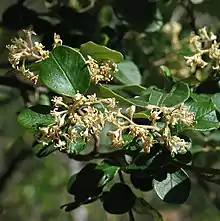| Cotoneaster pomaderris | |
|---|---|
 | |
| Pomaderris cotoneaster in the Bungonia State Conservation Area | |
| Scientific classification | |
| Kingdom: | Plantae |
| Clade: | Tracheophytes |
| Clade: | Angiosperms |
| Clade: | Eudicots |
| Clade: | Rosids |
| Order: | Rosales |
| Family: | Rhamnaceae |
| Genus: | Pomaderris |
| Species: | P. cotoneaster |
| Binomial name | |
| Pomaderris cotoneaster | |
Pomaderris cotoneaster, commonly known as cotoneaster pomaderris,[2] is a species of flowering plant in the family Rhamnaceae and is endemic to south-eastern continental Australia. It is an erect shrub with woolly-hairy stems, elliptic leaves, and leafy panicles of cream-coloured flowers.
Description
Pomaderris cotoneaster is an erect shrub that typically grows to a height of 1–4 m (3 ft 3 in – 13 ft 1 in), its branchlets densely covered with woolly, white, star-shaped hairs. The leaves are egg-shaped to elliptic, 15–30 mm (0.59–1.18 in) long and 10–15 mm (0.39–0.59 in) wide, the upper surface with bristly hairs and the lower surface densely covered with soft, star-shaped, white and rust-coloured hairs. The flowers are cream-coloured and borne in leafy, more or less pyramid-shaped panicles 30–100 mm (1.2–3.9 in) long, each flower on a pedicel 1.5–2.5 mm (0.059–0.098 in) long. The floral cup is 0.5–1.0 mm (0.020–0.039 in) long, the sepals 1.6–2.0 mm (0.063–0.079 in) long but fall off as the flowers open, and there are no petals. Flowering occurs in October and November.[2][3][4][5]
Taxonomy
Pomaderris cotoneaster was first formally described in 1951 by Norman Arthur Wakefield in The Victorian Naturalist from specimens he collected near the Upper Genoa River in 1950.[6][7] The specific epithet (cotoneaster) means "quince-likeness".[8]
Distribution and habitat
This pomaderris grows in forest and woodland, often along rivers or on cliffs and is found from near Mittagong in New South Wales to the upper Genoa River in far north-east Victoria, but is rare in both states.[3][4]
Conservation status
Cotoneaster pomaderris is listed as "endangered" under the Australian Government Environment Protection and Biodiversity Conservation Act 1999, the Victorian Government Flora and Fauna Guarantee Act 1988 and the New South Wales Government Biodiversity Conservation Act 2016. The main threats to the species include climate change, grazing by herbivores, and weed invasion.[2][3][4][9]
References
- ↑ "Pomaderris cotoneaster". Australian Plant Census. Retrieved 30 January 2022.
- 1 2 3 "Conservation advice for Pomaderris cotoneaster (Cotoneaster Pomaderris)" (PDF). Australian Government Department of Agriculture, Water and the Environment. Retrieved 30 January 2022.
- 1 2 3 Harden, Gwen J. "Pomaderris cotoneaster". Royal Botanic Garden Sydney. Retrieved 30 January 2022.
- 1 2 3 Walsh, Neville G. "Pomaderris cotoneaster". Royal Botanic Gardens Victoria. Retrieved 30 January 2022.
- ↑ Wood, Betty. "Pomaderris cotoneaster". Lucid Keys. Retrieved 30 January 2022.
- ↑ "Pomaderris cotoneaster". Australian Plant Name Index. Retrieved 29 January 2022.
- ↑ Wakefield, Norman A. (1951). "New species of Pomaderris". The Victorian Naturalist. 68 (8): 141–142. Retrieved 30 January 2022.
- ↑ Sharr, Francis Aubi; George, Alex (2019). Western Australian Plant Names and Their Meanings (3rd ed.). Kardinya, WA: Four Gables Press. p. 71. ISBN 9780958034180.
- ↑ "Cotoneaster pomaderris - profile". New South Wales Government Department of Environment and Heritage. Retrieved 30 January 2022.
